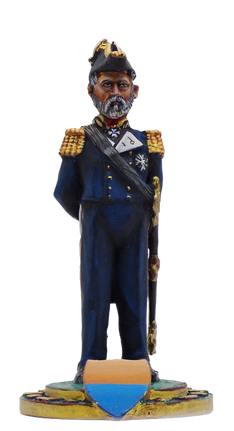
Baron Svante Natt och Dag
Svante Adam Knutsson Natt och Dag, born on 31 December 1861 in Karlskrona Admiralty parish, died on 9 October 1906 in Stockholm, was a Swedish naval officer and member of the Swedish Parliament (Liberal). Svante Natt och Dag graduated from the Naval Academy in 1881 and served in the British navy from 1888 to 1890. In 1903 he was appointed Commander 2nd Class in the Navy. He was a member of parliament for the Liberal Party in the second chamber for the constituency of Stockholm from 1903 to 1906. In the Riksdag, he was a member of the special committee in 1906. As a politician he was mainly active in defence matters.


The Swedish Navy (Swedish: Svenska marinen) is the maritime service branch of the Swedish Armed Forces. It is composed of surface and submarine naval units – the Fleet (Flottan), formally sometimes referred to as the Royal Navy (Kungliga Flottan) – as well as marine units, the Amphibious Corps (Amfibiekåren). Founded under King Gustav I in 1522, the Swedish navy is one of the oldest continuously serving navies in the world, celebrating its 500th anniversary in 2022. Early Swedish kings (c. 9th–14th centuries) organised a Swedish Navy along the coastline through ledungen. This involved combined rowing and sailing ships (without artillery). This system became obsolete with the development of society and changes in military technology. No later than in the 14th century, the duty to serve in ledungen was replaced by a tax. In 1427, when Sweden was still part of the Kalmar Union (with Denmark and Norway), Swedish warships did however participate in the naval battle of Öresund against the Hanseatic League. It is unclear how this force
was organised and exactly on what basis. On 7 June 1522, one year after the separation of Sweden from the Kalmar Union, Gustav Vasa purchased a number of ships from the Hanseatic town of Lübeck. Official Swedish histories since the 19th century have often recorded this day as the birth of the current Swedish Navy. The museum ship Vasa in Stockholm was a 17th-century ship of the Royal Swedish Navy (Kungliga flottan). The Amphibious Corps dates back to 1 January 1902, when a separate "Coastal Artillery" (Kustartilleriet) was established, and Marinen came into use as the name of the service as a whole.

Natt och Dag (lit. 'Night and day') is a Swedish noble family and the oldest surviving family of pure Swedish extraction, with origins stretching back at least as far as the late thirteenth century. However, the actual name Natt och Dag, alluding to the contrasting colours of its coat of arms, was not coined until the sixteenth century, and was not used as a surname by the family itself until the eighteenth century It is therefore customary to write the name in parentheses (e.g. Bengt Stensson (Natt och Dag)) when applying it to individuals prior to 1700. The family's oldest known ancestor is the knight, Lawspeaker of Värend, and Councillor of the Realm Nils Sigridsson (Natt och Dag), who is first attested in a document from 11 May 1280 and lived at Ringshult, near Torpa in Östergötland. It is possible the family's origins stretch even further back. Gabriel Anrep, a Swedish genealogist of the 19th century, wrote: That this family stems from Sigtrygg, a rich man, who, according to Sturlesson, in the year 1030 lived in Nerike and, during the winter, housed the Norwegian King Olof Haralsson the Holy, and that Sigtrygg's son Ivar thereafter became a distinguished man, may be true but lacks evidence. In the
fifteenth century, the family split into two branches. The junior branch, descended from Bo Stensson (Natt och Dag), adopted the surname Sture, although they continued to bear the Natt och Dag coat of arms, and thus are sometimes considered either as an offshoot of the Natt och Dag or as a separate dynasty, the Younger Sture Family. The Younger Stures enjoyed great prominence in the late fifteenth and sixteenth centuries. Svante Nilsson and his son Sten Sture the Younger ruled Sweden as regents (Swedish: riksföreståndare) during the period 1503-20, and Sten's sons Nils Stensson Sture and Svante Stensson Sture, and the latter's son Nils Svantesson Sture, were all important figures in Swedish politics during the reigns of Kings Gustav I and Erik XIV. This branch became extinct with the death of Svante Mauritzson Sture in 1616. The senior branch of the family was descended from Bo Stensson's elder brother, Bengt Stensson (Natt och Dag), who was a knight, Lawspeaker of Närke and Councillor of the Realm, and died circa 1450. The family again split in two after Bengt Stensson's grandson Johan Månsson (Natt och Dag), with one line descending from Johan's elder son Måns Johansson and the other from his younger son Åke Johansson. Åke's great-grandson and namesake Åke Axelsson (Natt och Dag) lived 1594-1655. He served as a Councillor of the Realm and also as Marshal of the Realm, and on 20 April 1652 he was ennobled by Queen Christina. With this the Natt och Dag were formally inducted into the Swedish nobility, and their coat of arms was added to the Riddarhus; however, this line died out in 1666 with Åke's grandson Carl Axelsson (Natt och Dag). The other line descended from Måns Johansson produced a number of military officers in the seventeenth and eighteenth centuries, during Sweden's Great Power Era, and in more recent times the prominent governmental official Åke Natt och Dag [sv] and the writer Niklas Natt och Dag. This branch of the family survives to the present day. One branch of the family resides in the United States, particularly the states of Alaska and Washington, using the truncated surname Dagg.
Awards: Insignia, sash and star of the Royal Order of the Polar Star (Kungliga Nordstjärneorden).






